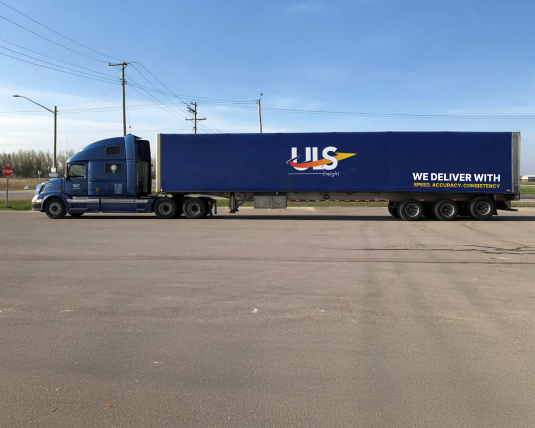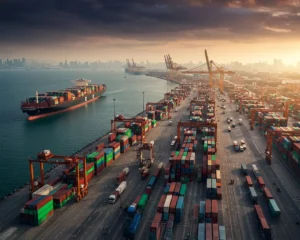Los Angeles Container Drayage: Linking U.S. West Coast Trade to Canada
- ULS Freight

The Port of Los Angeles and its twin, Long Beach, stand as the busiest container complex in North America, managing over 20 million TEUs annually. These ports connect Pacific Ocean trade with the inland U.S. and Canada, making Los Angeles Container Drayage the first and most critical link in the supply chain. Without fast and compliant drayage, containers stall at terminals, causing costly demurrage and missed rail connections.
Drayage connects ocean freight to inland modes — whether by rail, intermodal, or truckload. Every shipment that leaves the docks depends on an efficient short-haul movement from terminal to the next node. Businesses that export to or import from Canada rely on these drayage runs to keep cargo moving toward Canadian destinations.
Key Insight: Los Angeles acts as a gateway not just for California commerce but for U.S.–Canada freight routes that sustain continental trade.
As demand for near-real-time logistics increases, the importance of reliable drayage grows. Congested terminals, chassis shortages, and stricter environmental laws make it vital to work with an experienced Port of Los Angeles trade partner who understands both compliance and timing.
What Is Container Drayage and Why It Matters
Container drayage services refer to the short-distance trucking that moves shipping containers between port terminals, warehouses, and rail yards. It may cover only a few miles, but this step determines how efficiently freight transitions from ocean transport to inland delivery. In Port trucking Los Angeles, every hour counts — carriers must synchronize with vessel discharge, terminal gate appointments, and rail cut-off times.
Drayage comes in multiple types:
- Pier drayage: picking up containers directly from the dock for transfer to nearby yards.
- Inter-carrier drayage: shifting containers between port facilities or carriers.
- Door-to-door drayage: delivering containers straight to local warehouses or distribution centers.
When port congestion rises, drayage operators face tight appointment windows and longer wait times. Containers left too long in terminals incur per-diem charges, increasing cost per load. By coordinating scheduling and real-time tracking, reliable carriers minimize idle time and keep freight flowing.
Drayage also provides data continuity. Every scanned movement — from gate entry to container release — updates a digital trail that helps shippers verify compliance and performance. That visibility reassures importers and exporters who move time-sensitive or high-value cargo through California. Explore our drayage trucking services in Los Angeles.
How Los Angeles Links U.S. West Coast Trade to Canada
Most Canadian-bound ocean freight from Asia enters through Los Angeles and Long Beach, where drayage initiates inland transport. Containers move from port terminals to intermodal logistics corridors that lead toward Canadian cities. These lanes combine rail, trucking, and cross-docking to deliver cargo to final distribution hubs.
The primary corridors include:
- Los Angeles to Vancouver: Using Pacific rail lines and Interstate 5, this route supplies Western Canada’s ports and consumer markets.
- Los Angeles to Calgary: Serving Alberta’s manufacturing and energy sectors.
- Los Angeles to Toronto: Reaching central Canada through Chicago-based intermodal transfer points.
Each route carries strategic value. For Canadian businesses, sourcing through Los Angeles cuts lead times on Asian imports compared with East-coast arrivals. U.S. exporters benefit by consolidating loads and accessing the same infrastructure for northbound freight.
Drayage underpins this entire network by connecting ship arrivals to U.S.–Canada freight routes quickly and cleanly. Every hour saved at the port compounds along thousands of miles of inland transport, improving delivery speed and lowering inventory costs. See our cross-border logistics solutions for Canada.
Customs & Cross-Border Compliance Made Simple
Cross-border freight demands precision. Any missing form or incorrect tariff code can halt cargo for days. To simplify the process, reliable carriers coordinate with licensed customs brokerage U.S.–Canada partners who manage paperwork and ensure clearance under trade regulations.
Essential Documentation Checklist
Document | Purpose | Responsible Party |
Commercial Invoice | Declares value and description of goods | Shipper |
Bill of Lading (BOL) | Legal contract of carriage | Carrier |
Packing List | Confirms contents and weight | Shipper |
Certificate of Origin (CUSMA/USMCA) | Confirms eligibility for tariff exemption | Shipper / Broker |
Importer Security Filing (ISF) / eManifest | Required for electronic clearance | Broker / Carrier |
Professional logistics teams handle import/export documentation, pre-file data through electronic portals, and coordinate with both CBP and CBSA. The use of Automated Commercial Environment (ACE) and Advance Commercial Information (ACI) systems allows cargo to clear faster once it reaches the border.
Shippers who rely on customs brokerage services gain peace of mind — paperwork is validated before departure, HS codes are reviewed, and tariffs are accurately declared. That reduces compliance risk and keeps goods flowing northward without inspection delays. Learn how our customs experts handle U.S.–Canada freight clearance.
The Technology Behind Modern Drayage
Technology now defines competitive drayage. Carriers employ GPS-enabled drayage tracking and intermodal automation to optimize operations and share data with clients. When a container leaves the Port of Los Angeles, real-time updates show its location, expected arrival, and potential delays.
Smart freight management systems provide several advantages:
- Route optimization: Algorithms suggest the fastest or least congested paths.
- Digital paperwork: Electronic BOLs and signatures reduce errors and manual tasks.
- Predictive analytics: Platforms forecast dwell times and improve chassis utilization.
For shippers, these innovations translate into visible, traceable shipments and faster billing cycles. Digital platforms integrate directly with rail lines and warehouses, ensuring continuous data flow.
Drayage technology also supports sustainability. Idle-time monitoring helps reduce emissions, while load-matching algorithms cut empty miles. These tools align with California’s clean-air regulations and corporate ESG goals. Discover our smart logistics technology solutions.
Challenges in Drayage & How to Overcome Them
Even in a tech-driven environment, drayage faces real-world pressures. Port congestion Los Angeles, equipment shortages, and regulatory restrictions often disrupt operations. The key lies in proactive planning and collaboration among carriers, terminals, and clients.
Common Drayage Challenges
- Container delays from vessel bunching and off-peak storage limits.
- Chassis shortages that prevent immediate pickup.
- Environmental regulations restricting diesel truck access.
- Scheduling gaps between terminal appointment systems and trucking fleets.
Solutions That Work
- Early scheduling: Booking terminal slots before vessel arrival avoids bottlenecks.
- Fleet flexibility: Using multiple yards or chassis pools prevents equipment downtime.
- Green drayage adoption: Electric or low-emission trucks comply with California Air Board standards and improve corporate sustainability metrics.
- Real-time communication: Sharing updates between dispatchers and port coordinators minimizes detention.
Sustainable freight solutions are becoming mandatory. Companies that adopt eco-friendly fleets and optimize timing reduce both carbon output and operating cost. Read more about sustainable drayage practices.
Choosing the Right Drayage Partner in Los Angeles
Selecting the right logistics partner affects every downstream operation. The best drayage companies Los Angeles combine compliance, technology, and transparency. They maintain direct relationships with terminals, have certified drivers, and keep modern fleets ready for 24/7 dispatch.
What to Look for in a Drayage Partner:
- Proven record of on-time delivery and safety.
- Integrated tracking and customer portals.
- Adequate equipment capacity — trucks, chassis, and yard space.
- Experience in intermodal freight partnerships and cross-border coordination.
Reliable partners also assist with insurance, documentation audits, and customs filing. Unverified carriers, on the other hand, risk penalties and container holds that can erode client trust.
When evaluating a reliable trucking carrier LA, verify their port permits, safety ratings, and environmental compliance. The most dependable teams operate with redundancy, ensuring no missed pickup even during peak congestion. Request a drayage service quote from our Los Angeles team.
How ULS Streamlined Port-to-Canada Freight
A recent logistics project handled by United Logistics Solutions (ULS) demonstrates how precision and planning in drayage can transform a complex cross-border shipment into a seamless delivery. A Canadian electronics distributor faced repeated delays importing high-value goods from Asia through the Port of Los Angeles due to congestion, inconsistent handoffs between carriers, and customs hold-ups. ULS was brought in to optimize the entire route — from the dock to the final warehouse in Toronto.
Upon vessel arrival at Pier 400, ULS deployed its dedicated drayage fleet to collect the containers within hours of unloading. Using real-time GPS tracking and automated dispatching, the containers were moved directly to ULS’s partner intermodal rail yard in Los Angeles, where trained staff coordinated immediate transfer onto a double-stack train bound for Toronto. Simultaneously, the customs documentation was pre-cleared through ULS’s digital brokerage system under CUSMA, preventing the common multi-day delay at the border.
In total, the freight completed its journey from Los Angeles → Chicago → Toronto in just eight and a half days, cutting transit time by 25 percent compared to the client’s previous logistics setup. ULS’s integrated visibility tools allowed the client to monitor each leg in real time, while the advanced route optimization system reduced idle mileage and carbon output by nearly 15 percent.
This case highlights how ULS’s end-to-end drayage and cross-border coordination deliver not just speed and cost efficiency, but also the reliability that importers depend on for continuous supply chain performance.
Get a Drayage & Cross-Border Freight Quote
Your supply chain deserves precision from port to customer. Our Los Angeles Container Drayage team connects vessels at the Port of Los Angeles with rail and trucking networks that serve every major Canadian city. We manage customs, compliance, and scheduling with the same focus on speed and reliability that defines top-tier logistics.
Whether you need single-container pickup, full-fleet drayage, or integrated cross-border freight quotes, our specialists provide data-driven estimates and real-time support. Optimize your port operations, minimize dwell time, and keep Canadian deliveries on schedule.
Get Your Free Drayage Quote Today. Contact our Los Angeles drayage specialists now.
FAQ — Container Drayage & Cross-Border Shipping
Drayage moves containers between ports, rail yards, and warehouses using short-haul trucks. The carrier picks up the loaded unit from a terminal, completes inspection, and delivers it to the next logistics point. This step is crucial for connecting maritime and inland transport without delay.
Yes. Containers are drayed from Los Angeles or Long Beach to rail terminals, then shipped via intermodal trains to Vancouver, Calgary, or Toronto. Through-billed contracts allow continuous tracking under one freight document.
Rates vary by terminal congestion, fuel price, and chassis use. On average, Los Angeles drayage costs range from USD $4.00 – $6.00 per mile for standard 40-ft containers. Scheduling efficiency and off-peak pickups can lower total cost.
Most coordinate with customs brokers who prepare all import/export forms. A professional drayage company ensures that documents like the commercial invoice and bill of lading are accurate before the container leaves the port.
Typical door-to-door delivery takes 4 to 7 days depending on weather, customs, and rail connections. Using pre-cleared documentation shortens transit and ensures faster border release.
About ULS Freight
We are Road freight forwarder based in Canada, and offering our road freight services all across the USA, Canada, and Mexico for the last 10 years.
Recent Posts

The Global Supply Chain Crisis: How Logistics Companies Are Responding

Cross-Border Freight Challenges: Navigating Compliance in a Global Market

